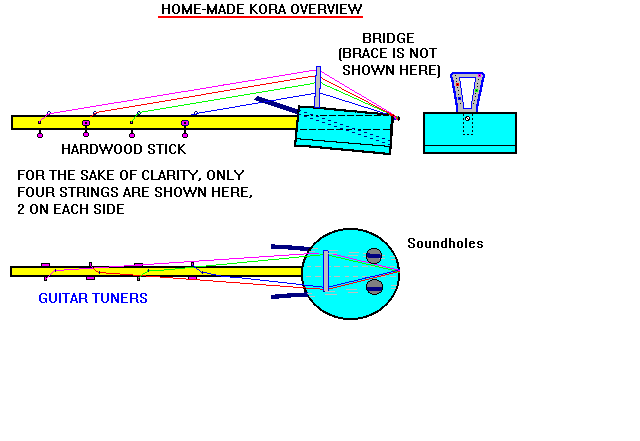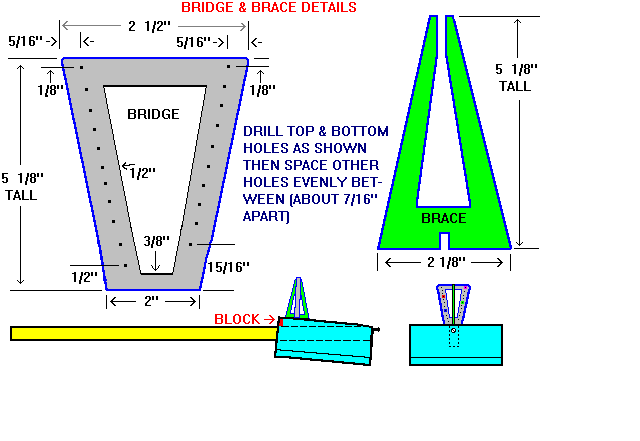 Building your own Cora
Building your own Cora Building your own Cora
Building your own Cora
by Dennis Havlena - W8MI Mackinac Straits, northern Michigan Please note: I am still experimenting with this instrument and changes to this article are likely.
I was going to call this a "kora-like" instrument, but it plays and sounds so much like the African-built instrument that it IS a kora, even if the construction materials and methods might be different.
The kora is from west African & is a 21 stringed instrument in the harp family whose neck & body vaguely resembles a big banjo. There are two "planes" of strings - one for the left and one for the right hand. these strings don't ride over the bridge/faceplate horizontally (like a guitar or banjo), but rather vertically - 11 strings "high" on one side & 10 "high" on the other.The scale is produced by alternately plucking first a string in one "plane", then one in the other "plane", right, left, right, left etc on up the scale, making this instrument a sort of a "stringed kalimba" & quite easy to play at least basic melodies on.
I built this kora during the Christmas '97 holiday in about 4 days of by-no-means-constant tinkering. Total cost was in the area of $20 - $30 using all new materials.
The finsihed instrument is sturdy yet lightweight, weighing just over 2 lbs, and measures 44 3/4" tall by 10" wide by 8 3/8" front to back.
This is a full list of materials:
Construction Steps

Body/Resonato
Take off the lid & turn the cake-tin upside down. Using a hefty utility knife, carefully cut out all of the bottom tin EXCEPT for leaving a 3/16" wide ledge all around the perimeter. The soundboard (which is recessed a bit) rests on & is glued onto this ledge.
Cutting the soundboard
Make this a tad larger in diameter than will fit into the ledge in the body then carefully sand/file the perimeter til it just plops into the ledge. Cut the two 1 3/4" diameter soundholes as shown in the.gif drawing. Glue the soundboard onto the cake-tin bottom's ledge using vinegar-smelling 100% silicone sealant (avoid "Silicone 2" at all costs).
Adding the underside brace
Made of any hardwood about 6" long, 3/16" wide and 3/8" tall at the center, tapering off to 1/8" or so at each end. Glue this below where the bridge will sit. Part of this may have to be notched a bit to allow the hand-grips to pass. More on this later.
Mounting tuning gears along the neck
One would think adding these 21 tuners would make the neck excessively heavy, but this is no problem at all - particularily as the instrument itself is so very light. Mount 10 tuners on the neck along the side that will be played by the right hand and 11 tuners on the neck along the side that will be played by the left hand. Locate them like so: Along the side played by the right hand, locate tuners (center of post) at these distances from the tip end of the neck (the end furthest from the instrument's body): 2 3/8", 5 3/4", 8 5/8", 11 1/8", 13 5/8", 15 3/4", 17 3/4", 19 1/2", 21 1/4" & 23"
Along the side played by the left hand, locate tuners (center of post) at these distances from the tip end of the neck (the end furthest from the instrument's body): 3/4", 4 1/8", 7 3/8", 9 7/8", 12 1/2", 14 3/4", 16 3/4", 18 5/8", 20 3/8", 22 1/8" & 23 7/8"
Installing the screw-eye string-routers/nuts
Locate these 1" or so in front of & in line with each tuner. Towards the higher pitched 5 or 6 strings strings it is necessary to sink the screw-eyes quite deep into the wood or even cut/reform them, to make a smaller/shorter eye. This is done to keep adjacent lower-pitched strings from hitting/buzzing where they pass over a higher-string's screw-eye ,
Mounting the neck to the body
Cut an angle on the end of the neck so it will match the tin on the inside flush. Lay masking tape over the area on the outside of the cake-tin that is to be cut to allow the neck to pass through. Draw a rectangle the same dimensions as the neck (the top surface of the neck should be 7/8" below the top of the soundboard). Very carefully, using a stout utility knife, cut out the rectangle where the neck will pass. Make a deliberate attempt to cut a bit smaller if anything, as this makes for a tight fit when the neck is forced through. Secure the end of the neck to the tin with two woodscrews - the bottom one being just 3/4" of an inch long or so, but the top one being stout & 2 1/2" long. All the strings attach to this screw (leave about 5/8" of this screw protruding -- it can be cranked in some once all the strings are on). It is very important to fit a small block of hardwood tightly into the space (on the inside of the tin & closest to the bridge end) between the neck and the bottom of the ledge/soundboard, right up against the tin's sidewall (position of this block is shown in the next .gif drawing). This takes bridge/string pressure off of the tin, which might contort otherwise. Glue this block to all possible surfaces using 100% silicone sealant (the type that smells like vinegar).
Bridge, string-holes & the brace to keep bridge upright

I have used both hardwood and the same 3/16" birch plywood used for the soundboard to make the bridge and braces and both woods work fine. Use a 1/16" drill-bit to make the holes for the strings (a slightly larger hole must be drilled for the low C string which is the longest string on the side of the instrument played by the left hand). A brace is not used traditionally but I find it works perfectly to keep the ever-present bridge-tipping at bay & don't believe it detracts very much from the overall tone/volume, it being quite light. The brace "fits inside" the bridge & is glued to the bridge wherever possible. Rubber-bands around this brace provide ample clamping while the glue is drying. It should be noted (after having broken the first one myself) that if you use non-plywood for this brace, it is fragile! Once glued to the bridge, it is very durable, but treat it gently before gluing. Also, cut the gap where the brace attaches to the top of the bridge very carefully -- make this gap just a tiny fraction larger than the thickness of the bridge, lest it break while clamping. Short lengths of 1/8" x 1/8" (or so) wood are then glued into all 8 angles where the brace meets the bridge for extra reinforcing. Carefully sand the bottom of this bridge/brace affair flat. This bridge does not need to be glued on. It's best to install & tension the shorter strings first though to keep the bridge from tipping while stringing. Make sure the bridge remains upright and in proper position as you install and tension the strings. Position the working edge of the bridge (the edge closest the tuners) 2 3/8" from the edge of the soundboard.
Hand grips
These provide a very practical & satisfying way to hold the instrument & position the thumbs and index fingers properly for playing. I used two 14" lengths of 5/8" dowel rod for this purpose. Refer to the accompanying illustrations. Drill a guide hole in the inside end of both rods to receive the short woodscrews that go through the tin side and secure the rods at the kora's end. Try to make the holes through the tin side to be just a bit under-sized, so that when the rods are forced through to the other side, they will be held tight. I initially intended to strengthen where the rods go through the holes in the tin sides with cement etc, but now don't think this is necessary - the instrument being so light. Make sure these rods don't threaten to hit the bottom of the brace glued to the soundboard's underside. If so, whittle a bit off the rods (& maybe even a bit off the brace) til there's no threat.
Stringing and Tuning the Instrument

Four different gauges of nylon line are used. I could find no information at all about the gauges of nylon line used by traditional African players, so had to do a LOT of experimentation, which is ongoing. The below is a workable system which plays and sounds good. Changes/improvements however, will be reported here.
My system for determining what gauge to use for a particular string is to start with a fairly thick line, see if it breaks when tuned to pitch, if it does, I substitute a slightly lighter gauge. I find that the string gauge just short of "breaking-thickness" produces the clearest, loudest note. The gauges below are the results of this experimentation:
Attach each string to the hefty screw in the end of the body/neck using a bowline knot, the most useful knot I know of. Because there's so much stretch with this type of nylon string, I find it advantageous to pull each string as tightly as possible while cranking the tuner. Cut off any string-end that's more than 3/4" long or so. Once the instrument is strung and tuned, Screw in the end-pin screw a bit.
There are several tunings used in Africa. It seems that the tuning shown in this article stands out as a favorite.
In addition to string stretch, the neck will bow some and the soundboard will sink in a bit. This all means that the first few day after stringing & tuning the beast, keeping it in tune will be a bit of a challenge! After several days the strings & everything else will have settled & tuning will not have to be often repeated. I used this type string on a simple cookie-tin banjo I made for my toddler daughter & (once stretched & settled) it's been about a year since I have had to retouch the tuning.
Appendix
Different types of tuners
The African-built kora normally uses leather rings slipped up and down the neck to tension/tune each string. While this may well work nicely, I've not yet tried it.
Inexpensive individual guitar tuning machines (as described in the above article) are the easiest way to go. Zither pins (several for a dollar from Elderly Instruments, Lansing, MI & elsewhere) can be used as well, although I have not tried them on a kora.
http://www.ehhs.cmich.edu/~dhavlena/